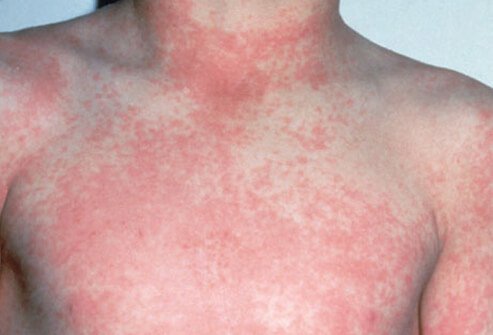The Five Common Symptoms of a Scarlet Fever Rash

If you are experiencing any of the following symptoms, you may be suffering from a scarlet fever rash. Although the rash itself is not life threatening, it can become quite itchy and irritated as time goes by. In this article, we will discuss these common symptoms.
The first symptom is the reddening of the skin, sometimes accompanied by blistering. The scarlet fever rash, just like sunburn, is usually as red as sunburn and has a very fine texture similar to gooseflesh ("snow goose" rash). It usually begins on the arm, neck and underarms, then spreads throughout the body. This type of rash is sometimes confused with a cold or other similar viral infection.
The second symptom is the appearance of flat or slightly raised red spots. These red spots can also bleed, although the bleeding is less than when the rash was first detected. Bleeding is often accompanied by a sore throat and a burning sensation in the mouth. Bleeding often lasts only a few days and is relieved by taking over-the-counter antihistamines or antibiotics. However, bleeding can continue for up to six weeks after the rash is first detected.
The third symptom is the appearance of small red rashes, protruding and flat. These rashes can be found on the face, neck, chest, and feet. These rashes may have a red base and a white center and sometimes red patches.
The fourth symptom is matted hair. The hair is usually brownish red, but it can also be a lighter shade of purple. The most common type of scarlet fever, called scarlet fever leukoplakia, usually occurs on the lower back, buttocks, and underside of the knees.
Symptoms of a rash often include redness, itching, burning, and soreness. You may also notice that when rubbed, the rash becomes irritated, making it difficult to scratch. Detailed information on this and other diseases can be found on the website Handal Dok.

While the most common symptoms of scarlet fever are easy to spot, you should always call your doctor if you experience any of them. For example, if you develop chickenpox-like blisters or sores or lumps under your skin, you should see your doctor. If your doctor suspects a virus, you should get tested as soon as possible.
No one should ever underestimate the importance of keeping a watchful eye out for scarlet fever. Even a mild rash can turn into something more serious, particularly if you don't act quickly. The rash itself is very painful and irritating, so it's important to avoid scratching and keep an eye out for any further signs of infection.
There are a few things that you can do to prevent the rash from spreading. If you suspect that you may have the rash, you should take some kind of antihistamine. Over the counter antihistamines or antibiotics can help to eliminate itching, but it's also important to keep the rash from spreading and keep the area where the rash was located clean and dry.
You can also treat scarlet fever rash if you notice a problem in the immune system. A weakened immune system is one of the leading factors in contracting the disease. If the immune system has been affected, then your body may be fighting off the rash without your knowledge.
A good way to treat this rash is to take a series of scarlet fever antihistamines such as Diflucan or Zantac. It can also help if you have a fever that goes away only when you get home from work or when you're in bed. This type of treatment will not cure the virus, but it will give you relief from the itch and inflammation and help you keep the rash from spreading. Antihistamines can also be taken to stop the spread of the rash.
If the scarlet fever rash doesn't go away in a couple of weeks, you should check to make sure that your immune system isn't compromised. If you have this type of rash, you should take some form of prescription medicine to fight it off.
